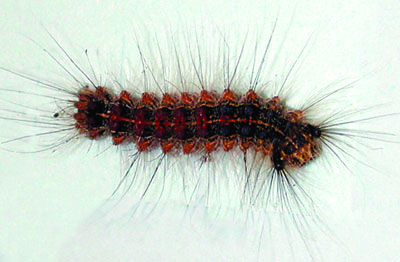Gypsy moth caterpillars found in urban Eaton County
Natural enemies help keep gypsy moth populations in check.

A small number of gypsy moth caterpillars were found feeding on bur oak in eastern Eaton County the week of May 24, 2015. Key identifying features of young gypsy moth caterpillars are long hairs covering dark-colored bodies and black head capsules. These early-instar larvae were about half an inch long.
Over a period of about seven weeks, the caterpillars grow to about 1.5-2 inches long. As they mature, the larvae develop five pairs of blue spots and six pairs of red spots on their backs. Moths pupate in protected sites, such as under loose flaps of tree bark or on woodpiles. After a period of pupation lasting about 10-14 days, adults emerge to mate and lay eggs beginning around mid-July. Females are creamy white with a wingspan of about 2 inches; males are brown with darker bands. Females cannot fly; they attract males with pheromones, mate and lay eggs near their pupation sites. Egg masses are laid in July to August.

Mature gypsy moth larva, about 1.5-2 inches long.
Gypsy moths are one of several leaf-feeding caterpillars that periodically appear in large numbers. Southeast Michigan experienced an outbreak of gypsy moths in 2013. Their preferred hosts include oak, maples, alder, willow, poplar, apple, hawthorn, elm and linden. However, many plants, including some conifers like spruce, may be eaten.
Gypsy moth populations rise and fall, partly due to the levels of natural enemies that help keep them in check. Gypsy moths have many natural enemies, including predators, parasitoids and pathogens. Entomophaga maimaiga, a fungus that infects gypsy moth caterpillars, and NPV, a virus, can cause a significant drop in populations within a couple of years of an outbreak. Natural enemies are especially important for keeping gypsy moth numbers in check.
“Natural Enemies of Gypsy Moth: The Good Guys!” is a Michigan State University Extension bulletin that provides more detail on identifying and preserving important natural enemies of gypsy moths.



 Print
Print Email
Email
